Retargeting is the most powerful weapon in your marketing arsenal, but only if you know how to use it.

See what I mean?
In fact, according to Google, retargeting can increase sales by a whopping 50% or more.
That means you could be missing out big time if retargeting isn’t part of your strategy. The good news is there’s no reason to miss out.
This guide will teach you how remarketing works and show you how to put it to work for your business. No fluff or complicated tactics – just stuff that works.
Okay, let’s get started.
What is Retargeting?
Retargeting is a form of advertising that lets you serve ads to individuals you’ve seen before. Specifically, those who’ve already visited your website or provided you with their email.
This feature distinguishes retargeting from other advertising types. For example, other strategies let you target people based on their presumed interests, demographics, and search queries. In contrast, retargeting requires gathered data from your desired audience ahead of time.
Gathering Data for Retargeting Campaigns
As I mentioned above, all retargeting campaigns require you to gather data and build an audience. You can do this in one of two ways:
- Use a retargeting tag/pixel
- Use a retargeting list
In the next two sections, we’ll explain how each method works and show you the best way to use them.
How Does Pixel-Based Retargeting Work?
Simple. When a user visits your site, a pixel or tag sends a cookie to their browser. After that, you can follow them around with ads on any site or app they use.
So I guess you could say the answer is cookies. Warm chocolatey delicious cookies…
Mmmm… who doesn’t love cookies
Okay, fine, not those kinds of cookies. Retargeting utilizes tracking cookies, which are small pieces of text sent and stored in people’s web browsers.
Cookies allow advertising platforms to serve users targeted ads. They use data from browsing history, preferences, and interests. In other words, cookies make retargeting possible. I think they’re almost as good as their edible counterpart.
You’ll also need to have a tracking tag set up on your website. A tracking tag (aka pixel) is a small piece of code on your website. The code delivers information to a server and places cookies on the user’s browser. This action enables you to create a retargeting campaign. If you don’t already have pixel tracking set up, be sure to do that first.
Pro tip: If you use multiple ad platforms and want to keep your tracking nice and organized, then I highly recommend Google Tag Manager.
How Does List-Based Retargeting Work?
List-based retargeting allows you to build an audience using a list of customer emails.
For list-based retargeting, all you have to do is upload a list of email contacts to the ad platform of your choosing. After that, you can start serving targeted ads to everyone on the list.
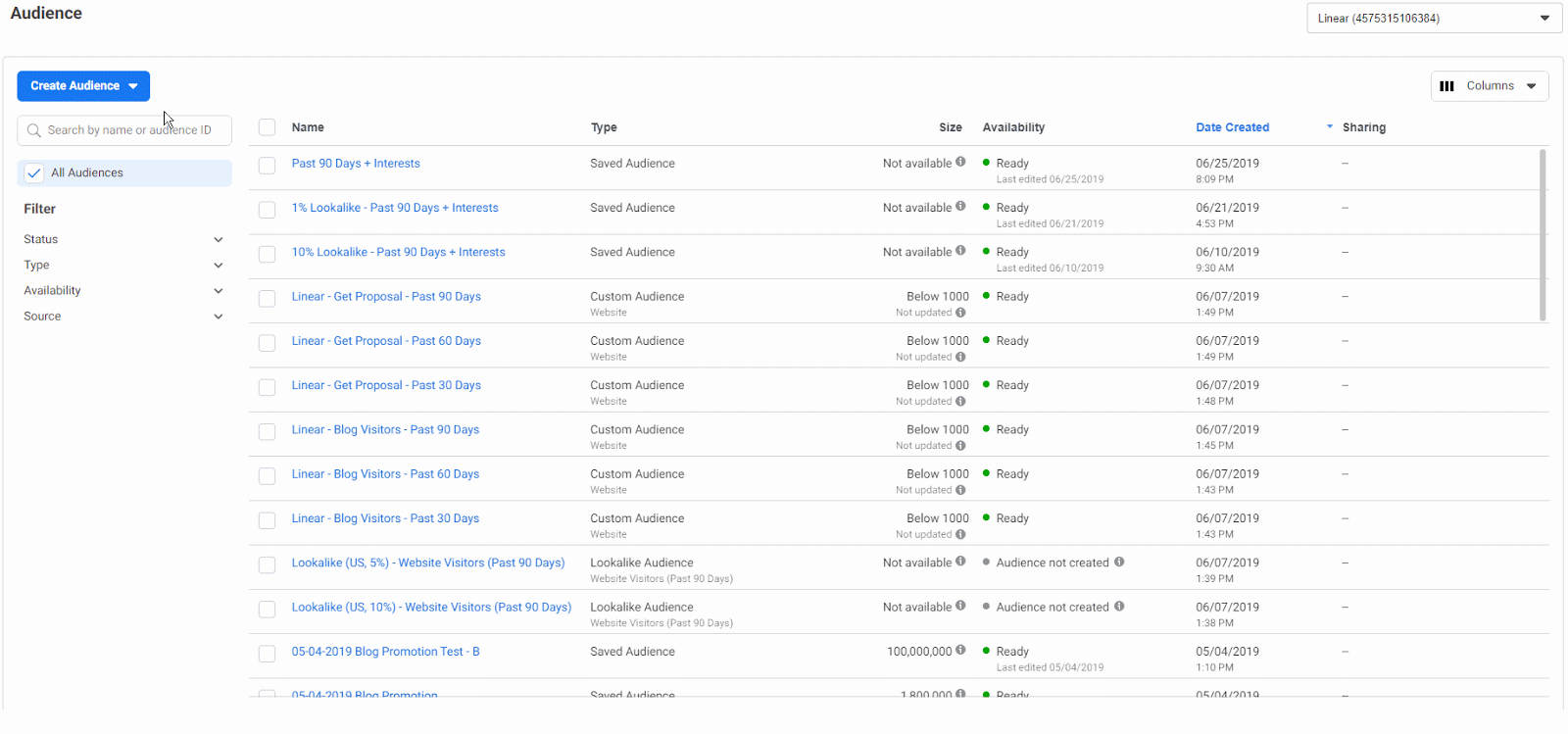
Uploading a customer list to Facebook Ads
List-based retargeting is a perfect way to get blog subscribers or people who’ve downloaded your gated content to take the next step and make a purchase.
Pro tip: Make sure that the people on the list willingly provided you with their email. For instance, buying lists and serving ads to cold prospects entirely defeats retargeting’s purpose and effectiveness. Ultimately, it’s your previous, authentic engagement with an audience that makes retargeting work.
Creating Retargeting Campaigns
For the most part, retargeting campaigns follow the same basic principles regardless of the platform. So we’ll skip the step-by-step tutorial for each platform and get straight to the good stuff.
In the next few sections, we’ll breakdown the most important rules to follow and provide you with a plethora of strategies to make sure your remarketing campaigns are a success.
Most Important Rules to Follow
Usually, I’d tell you to test everything and break all the rules. After all, every business is different, and what works for everyone else might not work for you. However, when it comes to retargeting, there are a few rules everyone should follow.
- Exclude Converters – To begin with, create an audience. Include everyone who visits your confirmation page or completes your conversion event. Then, either exclude these people from seeing your retargeting ads or move them to a new audience. If you choose to have a new audience, you should create ads specifically for customer nurturing, upselling, etc.
- Limit Frequency – Set a frequency limit. A limit prevents a small portion of your audience from absorbing your ad spend. Limiting frequency will also prevent uninterested people from becoming annoyed with your ads.
- Audience Segmentation – Retargeting everyone that visits your site is not advisable. Instead, narrow your remarketing audience to only the most relevant customers. Selectiveness will save you money and garner better results.
Feel like you have these basic rules down? Let’s move on to some retargeting strategies you can try next.
Retargeting Strategies
Now that you have some best practices under your belt, it’s time to pick a strategy that best fits your business. To make this process easier, we’ve compiled 17 of our favorite retargeting strategies.
1) Highly Engaged Visitors
Most retargeting solutions charge on a cost per impression (CPM) basis. That means you’ll be charged every time someone sees your ad, whether they engage with it or not. For this reason, your campaign’s success will largely be determined by who you decide to retarget.
For example, retargeting all site visitors includes people who bounced instantly and aren’t good candidates. You can quickly fix this problem by only retargeting highly engaged users.
One way to do this is to create a goal for visitors who stay longer than two minutes. This criterion will guarantee a higher quality retargeting audience.
Google Analytics is our go-to method for this because it links with Google Ads. This integration makes it super easy to import any audiences you create.
Start by creating a goal for users that stay on your website for two minutes or longer.
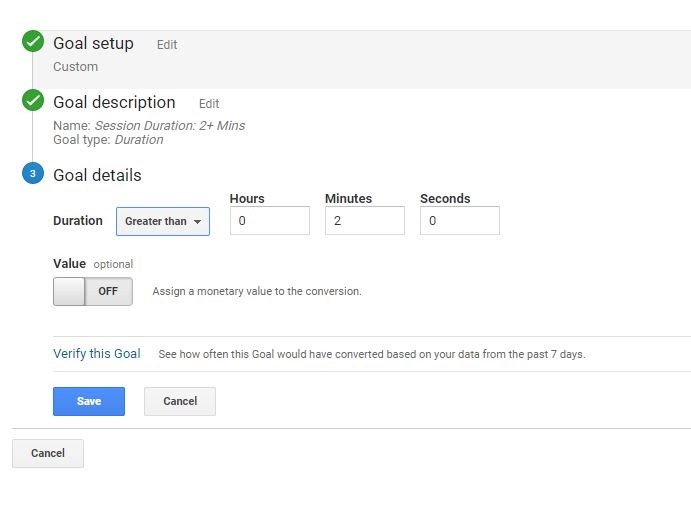
Creating a session duration goal in Google Analytics
After you’ve created the goal in Google Analytics, you can easily make an audience from users that complete that goal.
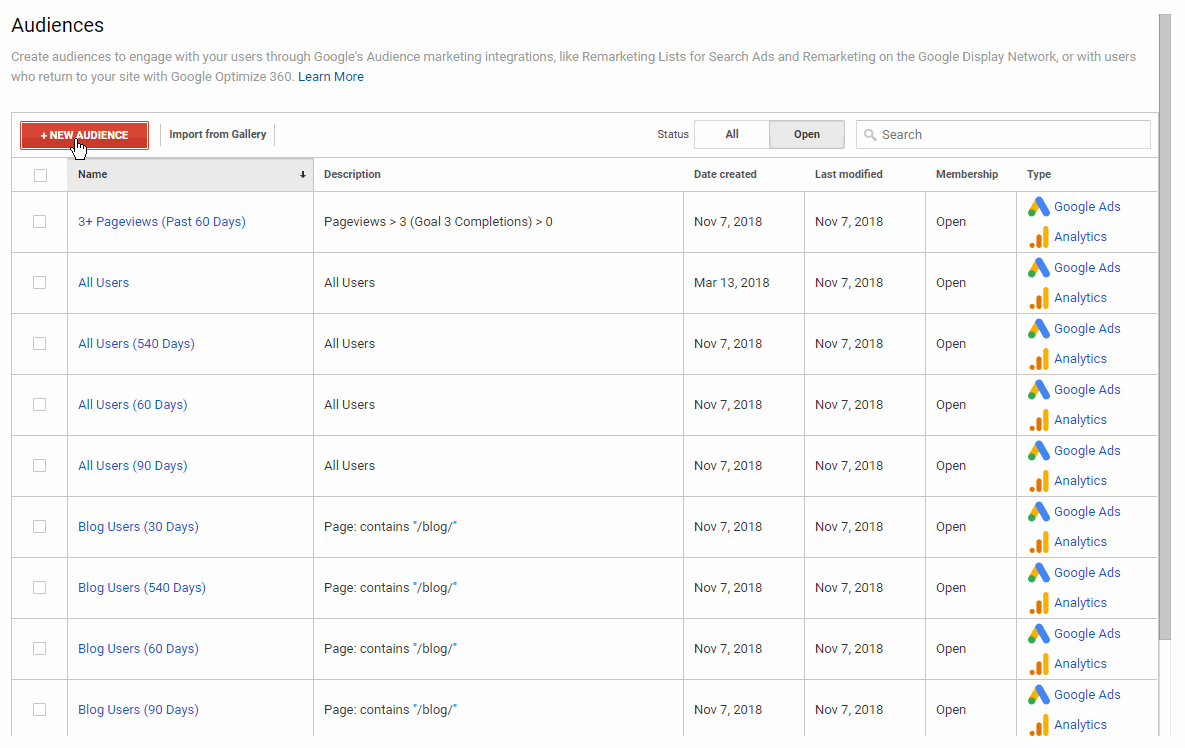
Creating your audience in Google Analytics
After you’ve completed these steps, you can easily import this audience into Google Ads and other ad platforms that link to Google Analytics.
Pro tip: This strategy can be used independently or added to most others on this list.
2) Funnel Based
This strategy is best suited for companies with high ticket products or services. The higher pricing typically results in a longer sales cycle. It also requires customers to take several actions before purchasing.
To properly execute this strategy, determine which actions you want visitors to take and in what order. Leverage this knowledge to set up a sequence of ads that guide users through your buying funnel.
Here’s an example of what this might look like:
- Customers visit your blog
- You retarget blog visitors with an ad to download a whitepaper
- Send everyone who downloads the whitepaper to a confirmation page
- You retarget everyone who visits the confirmation page with ads for a free trial of your software, product, or service
- Send everyone that signs up for the free trial to a confirmation page
- Retarget new users with ads to upgrade to the paid version. Now would be an opportune time to incentivize the upgrade. For example, offer a discount to anyone that signs up before the trial ends
As you can see, you can unite several retargeting campaigns to accomplish a greater end goal.
Set up funnel-based retargeting in Facebook
Now that we’re excited about its potential, how can you set this retargeting strategy up? Let me show you how to use Facebook Ads.
To begin, log into Facebook Ads Manager and navigate to the Audiences page.
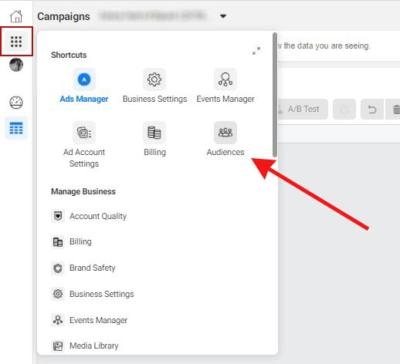
Facebook Ads Manager Audiences Page
Once you’re there, create a new custom audience that only includes blog visitors.
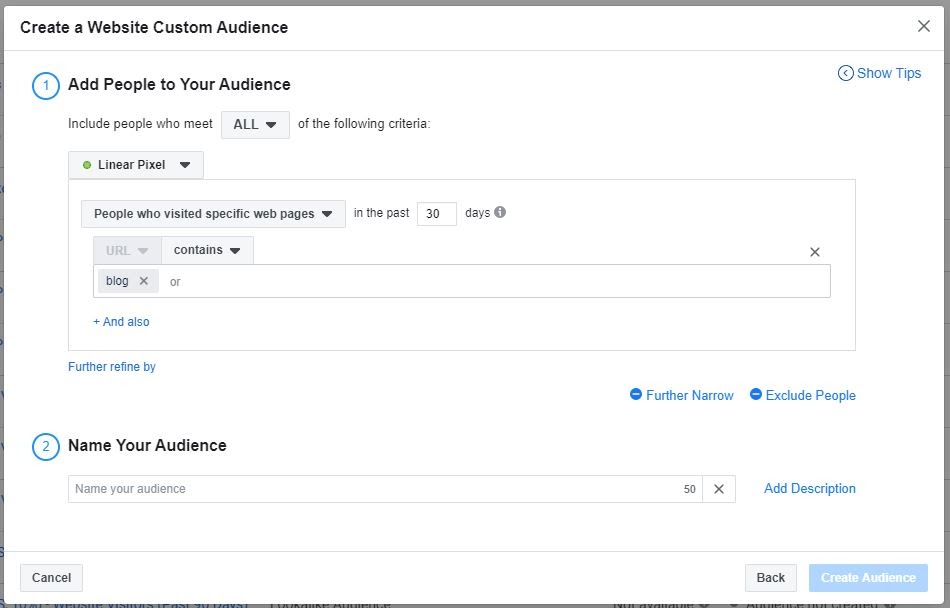
A Facebook audience retargeting blog visitors
Next, you’ll create a second audience for the people who downloaded your whitepaper.
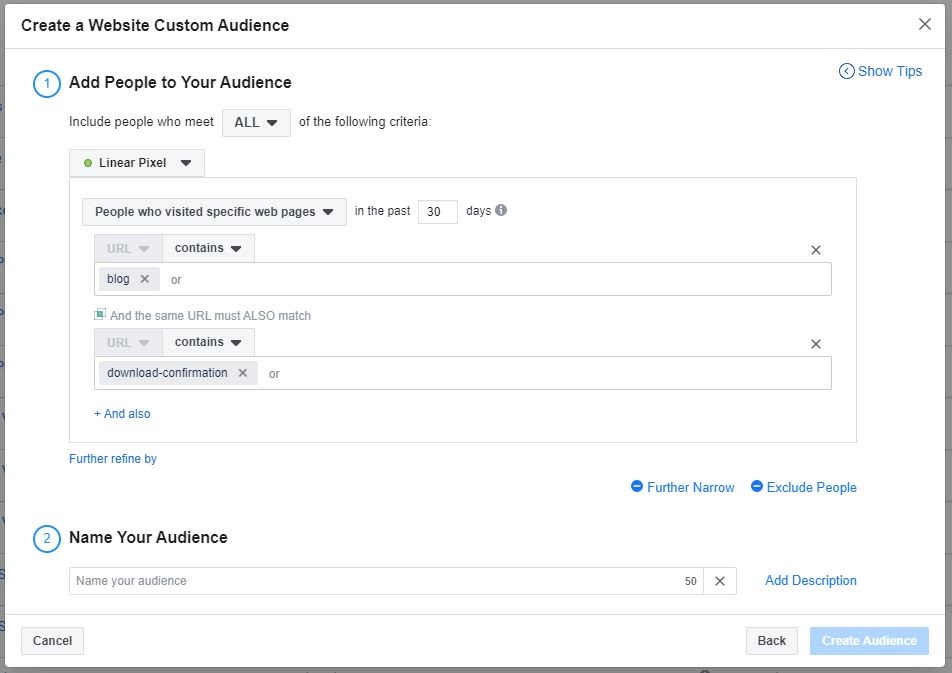
A Facebook audience retargeting people who’ve downloaded your whitepaper
Finally, create a third audience that includes people who’ve signed up for the free trial.
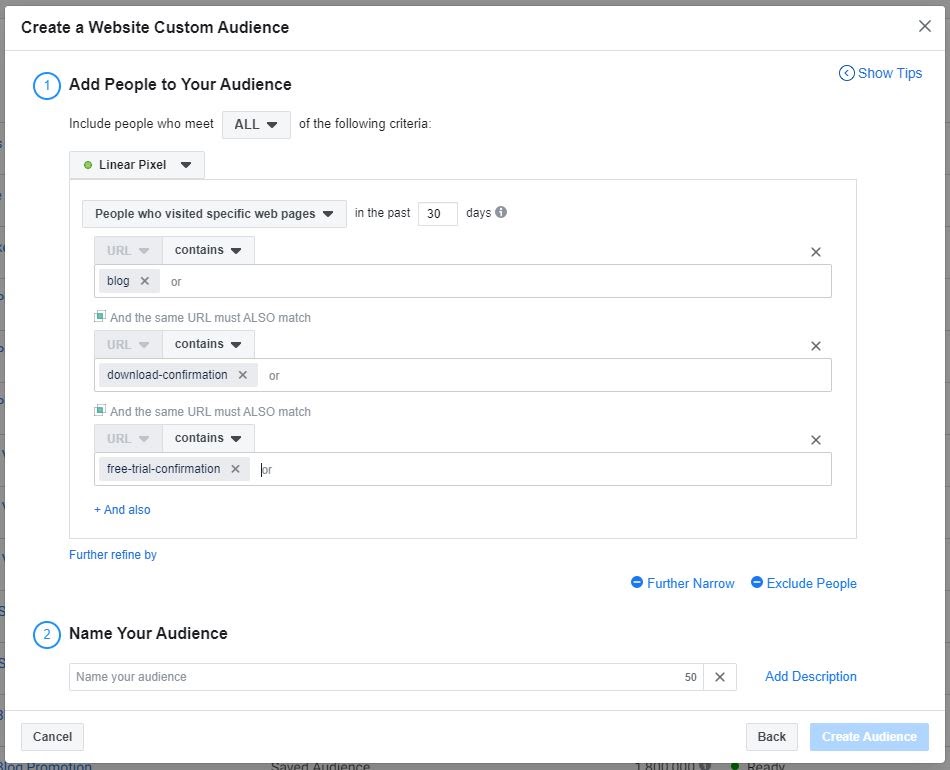
A Facebook audience retargeting free trial users
And we’re done! However, please note that this is not the only way to set up a funnel-based retargeting sequence. While the above examples are a useful starting point, you can ultimately try thousands of combinations.
3) Time Delayed
Time-delayed retargeting is one of the most flexible strategies. It can be used for almost any business, no matter what product or service they offer.
Here’s how it works:
- 1st Week – Show visitors ad #1
- 2nd Week – Show visitors ad #2
- 3rd Week – Show visitors ad #3
- etc.
Let’s say you’re a dental office trying to get new patients. You could use this strategy and switch between a few different ads, slowly increasing your offer’s value over time.
To illustrate, your first ad could build value and trust by showcasing patient testimonials. Your second ad might offer discounted teeth cleaning for all new patients. Whereas, your third ad could include a limited time offer with multiple perks, like free whitening and discounted cleaning.
Naturally, you can change the offers, timeframes, and the number of ads. Of course, this is just one example.
A word of caution: if you use this strategy, you must exclude users who convert in earlier weeks from your targeting. For example, exclude those who convert with ad #1 from the ad #2 audience, and so on. Doing so will prevent customers who convert on earlier ads from seeing later ads (and feeling ripped off by the lesser offer).
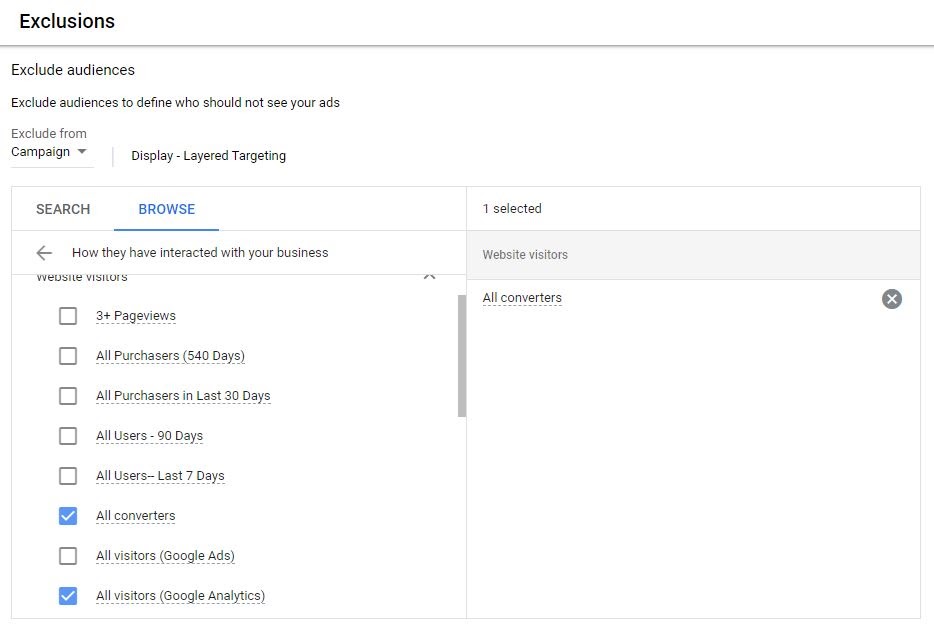
Excluding all converters in Google Ads
Adding exclusions is easy enough. Just finish creating your retargeting campaign in Google Ads. Then reselect the campaign, click on audiences, and choose exclusions from the dropdown.
4) Upsell & Cross-Sell
If you thought retargeting ads only work for people who’ve never purchased from you, then think again. In fact, studies suggest that customers who’ve already purchased from you have a 60-70% higher chance of converting.
Still not convinced?
What if I told you that repeat shoppers have an average order value of 3-5x greater than first-time buyers?
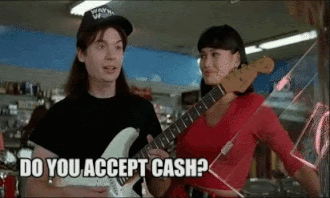
That’s some serious cash, am I right?
The bottom line is repeat customers are your best customers. They’ve already built trust in your business, so it’s easier to convince them to make another purchase.
For one of our clients, we created a retargeting campaign intending to cross-sell past customers. The ads showcase new items and explain the benefits based on the customer’s initial purchase.
Take a look at the results so far:

That’s almost a 17X return on ad spend (ROAS)
Don’t worry; this strategy isn’t exclusive to eCommerce companies. It’s also the perfect technique for companies that want to upgrade current members on a subscription service.
For example, let’s say your SaaS platform has three different pricing tiers. Consider customizing a retargeting campaign that upsells customers to higher-priced packages.
Pro tip: When you upsell customers, emphasize the additional features and benefits of the upgrade. Up-sell and cross-sell retargeting campaigns are your opportunity to show them what they’re missing out on.
5) Location Specific
Whether you’re a small local business or international company – geographic retargeting can drastically increase results.
It works because close is convenient. In general, people are conscious of their location and look for products and services close to them.
Let’s break it down. For starters, pull up your geographic report and sort by impressions.
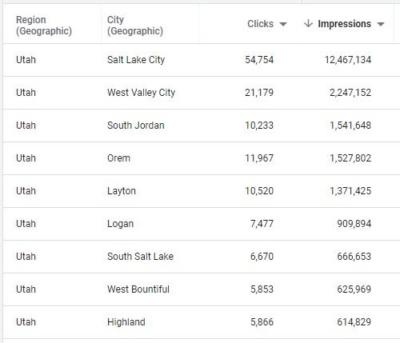
Google Ads geographic report
I recommend picking the location that has the highest number of impressions. More impressions will usually give you a bigger retargeting audience.
Next, you’ll need to create geographic-specific ads. Customize the ad copy or images to the location you’re retargeting.
Take this ad by Fixit Mobile, for example:
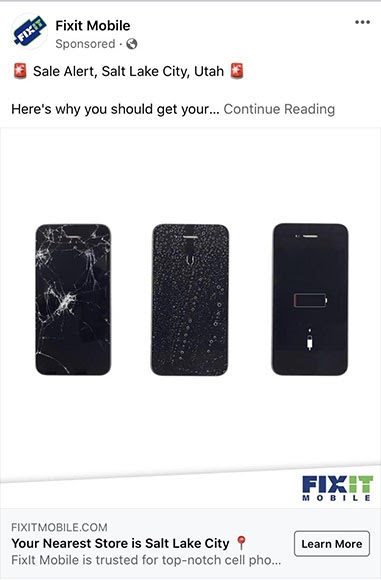
This ad retargets people in the Salt Lake City area
If your first campaign goes well, continue moving down the list creating a new retargeting campaign for each location.
Pro tip: For maximum results, pair your retargeting ads with a location-specific landing page. If you’re retargeting numerous locations, you can use dynamic text replacement. This tool will save time and eliminate the need for multiple pages.
6) Remarketing Lists for Search Ads (RLSA)
Let’s say someone visits your website. After browsing some key pages, they leave your site without calling you or filling out contact forms.

Ah, the sharp sting of rejection…
This is when Remarketing Lists for Search Ads (RLSA) comes to the rescue.
A few days later, the same person performs a search for one of your competitors. Boom! Your ad pops up first, and you score a new customer. Sounds pretty sweet, right?
It is pretty sweet, and it’s possible with RLSA.
Most retargeting focuses on following visitors with banners and video ads. RLSA sets itself apart. It offers you the ability to target past site visitors with fully customized search ads.
Additionally, RLSA doesn’t follow passive browsers on the web or social media. In other words, RLSA ads only show for users actively performing a relevant search.
Now, remember how RLSAs use data from previous site visitors? You already understand that this audience knows your brand. Thus they’re more likely to engage with your ad. That familiarity lets you do things with your search ads that you wouldn’t normally do like:
- Raise bids to show up higher in search results
- Customize your ads headline, description, etc.
- Bid on competitor terms
- Target broad keywords
- Bid on expensive keywords
To create an RLSA campaign in Google Ads, add remarketing audiences to an existing campaign or create a new campaign.
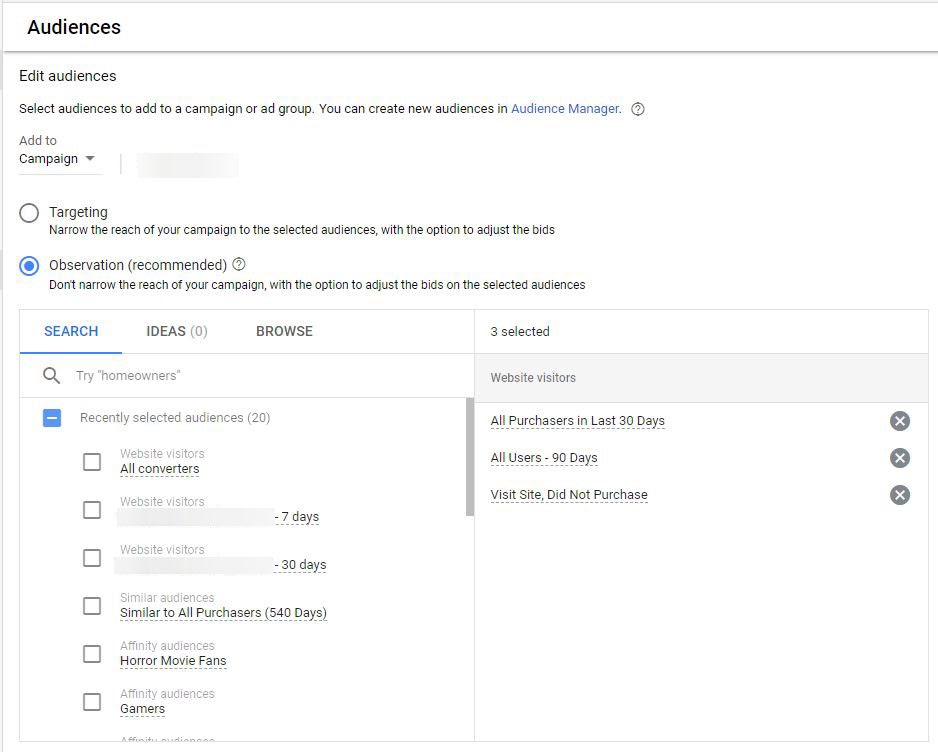
Adding audiences to search campaigns
You can also choose between two separate modes: Targeting and Observation. Targeting will limit your ads to people in your retargeting audience. Observation lets you see how past visitors behave and make bid adjustments without narrowing your audience.
Pro tip: In addition to search, you can also use RLSA for Shopping ads. Try adding discounts or promotions to get comparison shoppers back to your site.
7) Dynamic Retargeting
If you sell products online, then dynamic retargeting is going to be your new best friend.
Dynamic retargeting campaigns use templates or product feeds to populate product information automatically. It lets you show customers ads for products they recently viewed without manually creating hundreds or thousands of ads for each product.
Here’s an example of dynamic retargeting from Fitbit.
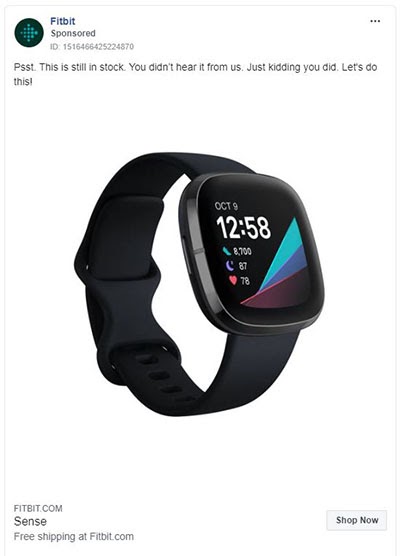
Fitbit’s dynamic Facebook ad
To create Facebook Dynamic Ads, you’ll need to create a product catalog. After that, you just make the retargeting campaign and let Facebook Ads do everything else.
For display retargeting on Google Ads, you’ll need to have a Merchant Center Account. Then you’ll be able to create a dynamic remarketing campaign.
Pro tip: Dynamic retargeting is even more effective when it’s paired with limited-time discounts, upsells, and cross-selling techniques.
8) Discount & Down Sell
Discounting and down selling can be a standalone strategy or an add-on to other retargeting tactics.
Down-selling is pretty straightforward for eCommerce, SaaS, or product-based companies. When someone visits your site, shows interest in your offer, and doesn’t convert, retarget them with ads for a less expensive product, package, or model.
If you’re a lead gen company, replicate the above process with multiple price points or service offerings.
Discounting is easier to implement. Even so, it’s trickier financially. Drop prices too low, and the cost of advertising might exceed profits (which defeats the purpose of advertising, to begin with). Ultimately, many businesses avoid them altogether.
But get this: there’s a way to offer insane discounts without losing money.
Here’s how you do it. Stop offering a flat discount like 30% off. Instead, charge full price and offer a gift card with each purchase. Buy one get one free (BOGO) offers work too. In our tests, this method is more effective and profitable than flat-rate discounts.
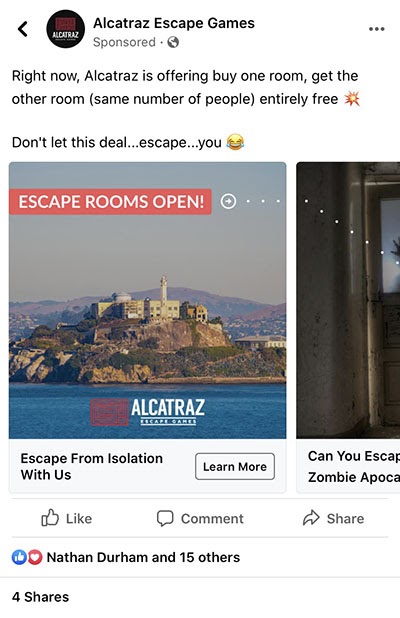
That BOGO offer is very tempting
The reason this discounting strategy works is three-fold:
- First, many customers who receive gift cards will never redeem them before the expiration date.
- Second, many customers will make a larger purchase there the second time around, as we mentioned earlier.
- Third, some customers will give the gift card away to friends and family. Not only does this grow your brand awareness, but many times these customers will also spend more than the amount on the gift card.
Pro tip: We recommend using discounts or down selling as the last step in time-delayed or sequential retargeting. A deal could be the final push that someone needs to make a purchase.
9) Referral Retargeting
People often tout referrals programs as the best form of marketing, and with good reason. According to a survey conducted by HelpLama, 84% of U.S. online consumers’ purchase decisions are influenced by their friends’ social media posts.
The good news is you can cash in on this lucrative referral marketing using retargeting campaigns.
Each time you get a new customer to convert, you put them into an audience of past converters. Then instead of excluding them, you’ll target them with ads aimed at extracting referrals.
To get the best results from your referral campaigns, be sure to incentivize your current customers. Offering money, free stuff, or discounts works very well. Companies like Robinhood, Lyft, and Uber all do a great job at this.
10) Intent-Based
We’re not sure this qualifies as retargeting since these visitors have never heard of you.
But it’s just too darn good, so we had to include it.

Seriously, it’s that good!
Intent-based retargeting is a strategy that lets you retarget people who searched for keywords related to your products and services, whether they visited your website or not.
To create an intent-based retargeting campaign, log in to your Google Ads account and create a new display campaign. Then click on content marketing in your ad group settings and choose keywords from the dropdown.
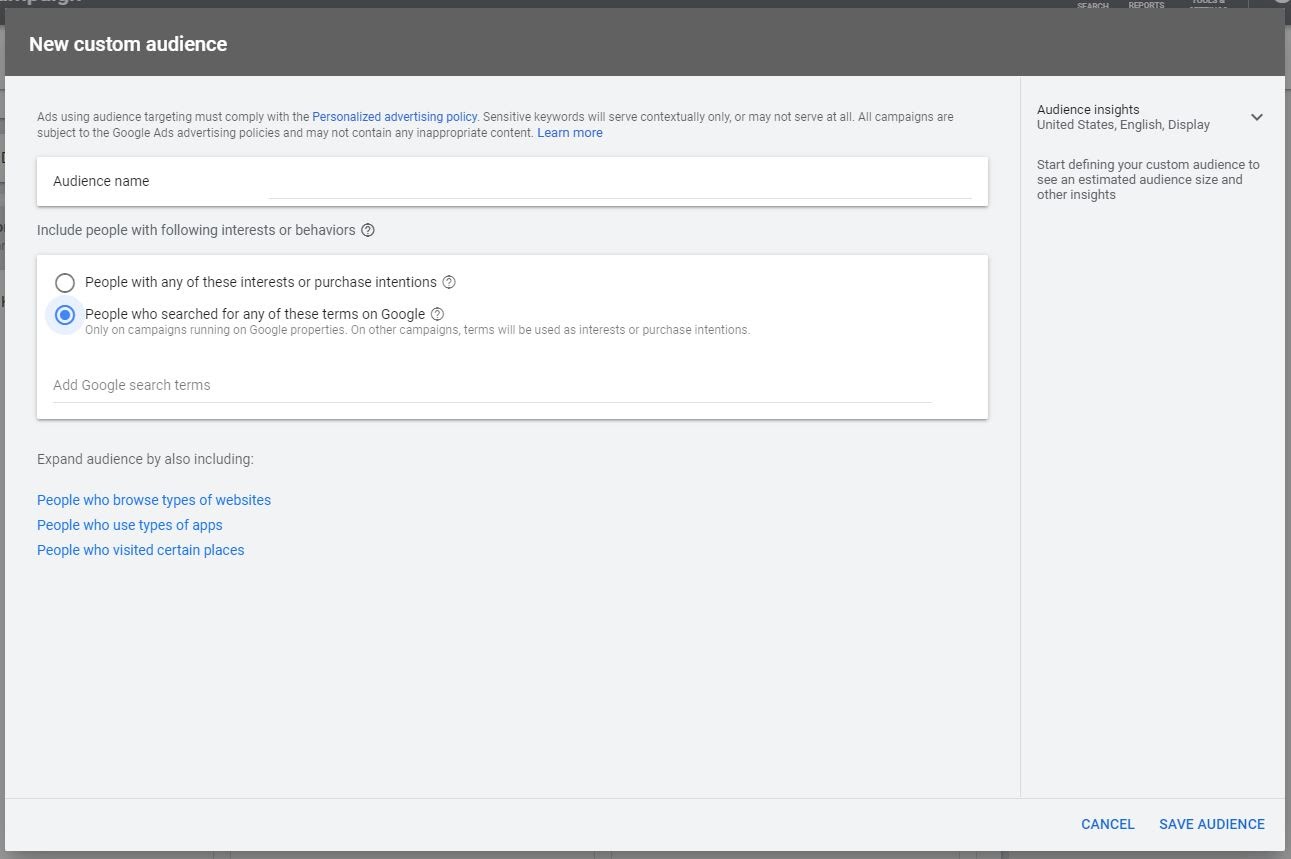
Creating intent-based audiences in Google Ads
Select “People who search for any of these terms on Google” and enter the keywords you want to retarget.
Once you’ve created ads, Google will show them to anyone who searches for the keywords you’ve targeted.
Since you know that the people seeing your ads have searched for specific keywords, you can personalize the ads you show them.
Pro tip: Intent-based retargeting can get in front of high-value customers for a fraction of what search campaigns cost. So if high CPC in search plagues your industry, give this strategy a try.
11) Time-Sensitive
Adding urgency to your retargeting efforts is a great way to increase conversions and shorten your conversion time lag.
Not familiar with the term?
Conversion time lag measures the gap of time between users seeing your ad and their conversion. Understanding time lag can help you build more effective retargeting campaigns.
To demonstrate, I’ll show you how we used this data to benefit one of our clients. Take a look:
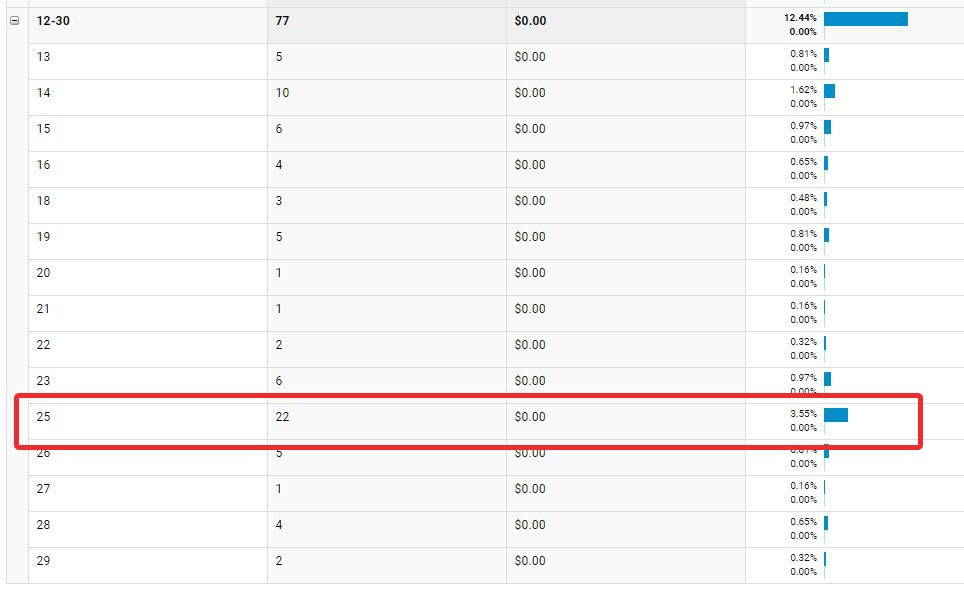
See the trend around day 25?
As you can see, the highlighted row shows a spike in conversions on day 25. In other words, more than 5% of conversions took 25 days or more.
So how did we respond?
We added a time-sensitive retargeting offer after the first 72 hours. As a result, we drastically shortened the conversion time lag. In fact, total conversions increased, and we reduced the conversion time lag to 48 hours.
Of course, there’s more to this strategy than just understanding the data. For the best results, you need a well-crafted offer that promotes urgency.
Take a look at this time-sensitive retargeting ad from TikTok:
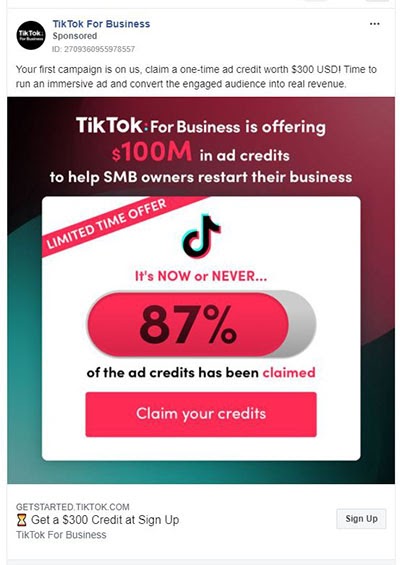
This ad is so good it just 🤯
TikTok really makes users fear missing out on this deal.
Fear of missing out (FOMO) is one of the best ways to create urgency and incentivize customers to convert.
Pro tip: Don’t try to trick customers with false claims. People are smarter than you think; they’ll catch on to a 24-hour sale that lasts for two months. Lack of transparency will kill brand trust and make future offers less effective.
12) Hyper Specific
Consumers face more noise than ever. With this in mind, it’s unsurprising that personalization is increasingly important.
What am I trying to tell you here? Merely showing the same generic retargeting ad to every site visitor won’t be enough to earn their attention.
Luckily, Facebook Ads allows you to segment your audience with hundreds of different criteria, including:
- Location
- Age
- Gender
- Relationship Status
- Work
- Language
- Education
- Home Ownership
- Parental status
- Life Events
- Interests
- Behaviors
The best part is, you can layer these targeting specifications into your retargeting campaigns for extreme granularity.
In this case, layered retargeting allows you to further segment your retargeting audience and create more personalized ads.
You start by selecting a retargeting audience you want to segment.
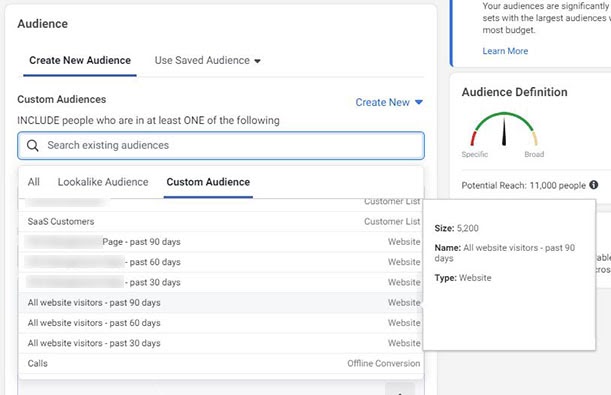
Selecting a retargeting audience in Facebook Ads
After that, you’ll layer additional targeting criteria on top of it. For example, let’s say you want to retarget Spanish speaking male runners between 35 and 55.
Here’s what that would look like:
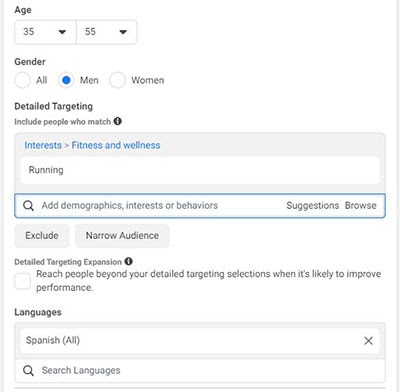
Adding additional audience requirements
Now you can create ads directed explicitly towards Spanish speaking male runners who’ve visited your website in the past 90-days.
Pro tip: If you already know who your very best customers are, this strategy could work wonders. You can still run your more general remarketing ads, too. Just save your hyper-specific audience and exclude it from your other retargeting campaigns.
13) Offer Change
If your paid search and social ads still aren’t converting even with retargeting, try not to be discouraged. Sometimes, no matter how much care you put into your ad campaigns, they flop.

It hurts just to watch
Don’t give up just yet, though. The problem may not be your ads or your targeting. More often than not, it’s your landing page offer that’s hurting conversions.
Consequently, asking visitors to schedule an appointment or book a demo the first time they come to your website could be ineffective. It’s a classic case of asking too much, too soon. In this scenario, include a less threatening offer with your retargeting campaign.
For instance, instead of asking them to book a demo, offer them a gated lead magnet like a free guide.
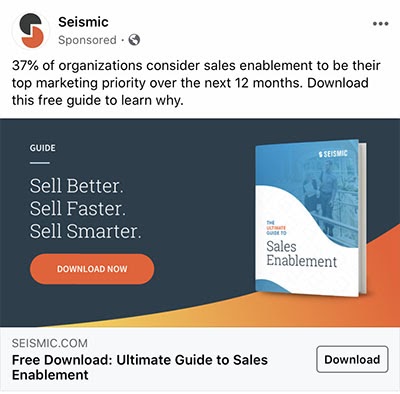
Seismic uses a free guide for its lead magnet
Lead magnets educate potential customers and improve your chances of getting them back to convert on your original offer.
14) Partner Retargeting
This strategy is perfect for hotels, airlines, and travel sites since their offers typically pair well together. After all, if you’re booking a flight to Las Vegas, you’ll probably need a place to stay. So why not partner up and share retargeting audiences?
The Wynn takes advantage of this strategy using ads like this:
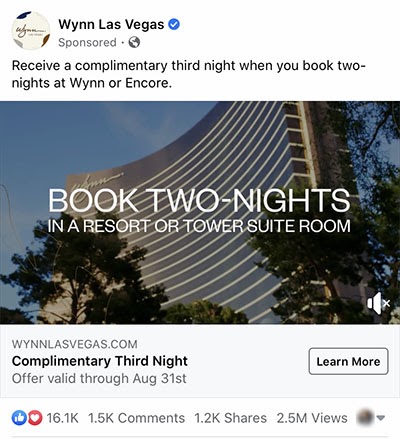
Partner retargeting ad
Partner retargeting isn’t limited to the travel industry, either. Any company that offers complementary products and services can benefit from partner retargeting.
Not to mention, Facebook Ads makes sharing audiences easy. Simply log in to Facebook Ads Manager and navigate to your audience dashboard. From there, you can select and share audiences with any of the businesses in your business manager account.
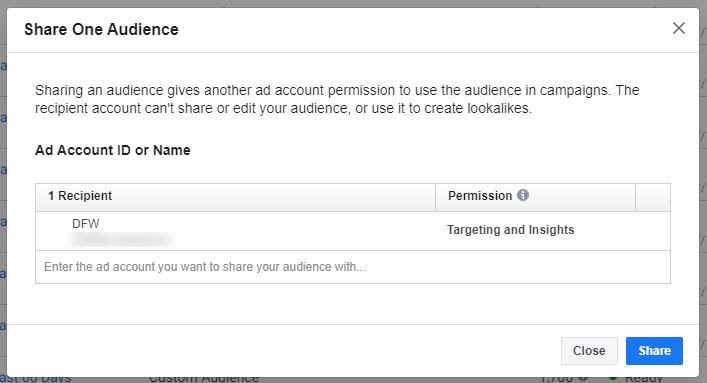
Sharing Facebook retargeting audiences
Unfortunately, Facebook limits audience sharing to the accounts you manage. The limit makes remarketing to another website’s visitors more challenging.
Luckily, platforms like Perfect Audience can help you connect with companies outside your business manager account. All you have to do is create an account, select a partner site, and tap a button. If the site owner agrees, you’ll be able to retarget their site traffic instantly.
Pro tip: Partner retargeting through these platforms costs 85% less and leads to higher lifetime values than Google Ads retargeting.
15) CPR Retargeting
Want to bring your old customers back to life?
Raise them from the grave with this retargeting technique.
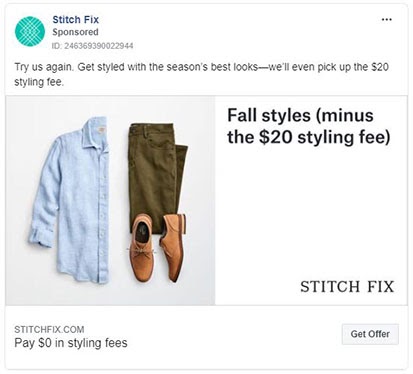
Stitch Fix knows how to win customers back 🙌
Although this retargeting strategy is especially useful for subscription-based companies, it also works for anyone who keeps a list of ex-customers.
To set up a CPR retargeting campaign, upload a list of your recently inactive customers to the ad platform of your choice. Then create a campaign that targets this audience.
Keep in mind, these customers canceled or became inactive for a reason. If you want to win them back, you’ll need to have a compelling offer.
Pro tip: Discounts aren’t the only way to win back old customers. Consider changing your offer entirely with upsells and cross-selling techniques (#4 in this list!)
16) Video Engagement
Ad platforms like Youtube and Facebook let you retarget visitors who’ve watched your videos, even if they never visited your website.
Much like funnel based retargeting, you can use a video series to move prospects through the customer journey.
For example, let’s say you have an innovative new product. You could create a video retargeting campaign that looks something like this:
Top of the Funnel – 1st Video – Promotes Awareness
- Mentions your brand and demonstrates the problem your product solves
Middle of the Funnel – 2nd Video – Builds Consideration
- Explains how your product works and why it’s better than other options
Bottom of the Funnel – 3rd Video – Creates Urgency
- Incentivizes viewers to buy now using time-sensitive discounts or promotions
To pull this off, you’ll need to have a series of videos (obviously). Creating the videos is the hardest part. Thanks to Google Ads, you can easily create video retargeting campaigns using ad sequences.
How to create Google Ads video retargeting campaigns
First, log in to Google Ads and create a new video campaign.
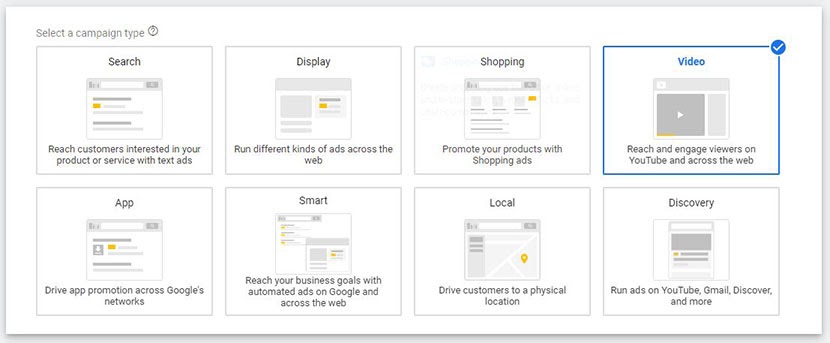
Select Video as your campaign type
Next, select Ad sequence as your campaign subtype.
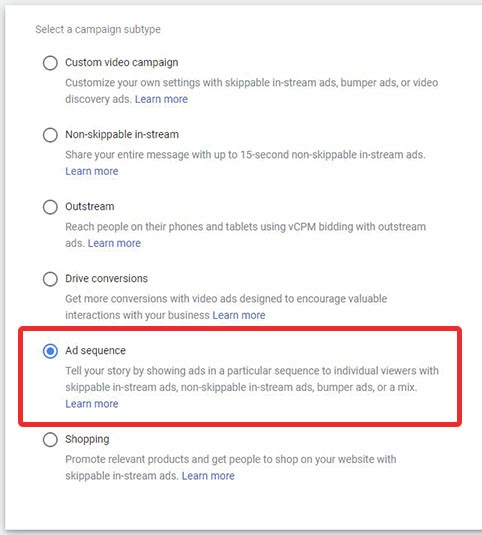
Ad sequence campaign subtype
Lastly, upload your videos and launch your campaign. That’s it! Google Ads will automatically show your video ads in the correct order.
However, if you plan on using Facebook, you’ll need to create retargeting audiences based on video engagement.
Don’t know how? I’ll show you here:
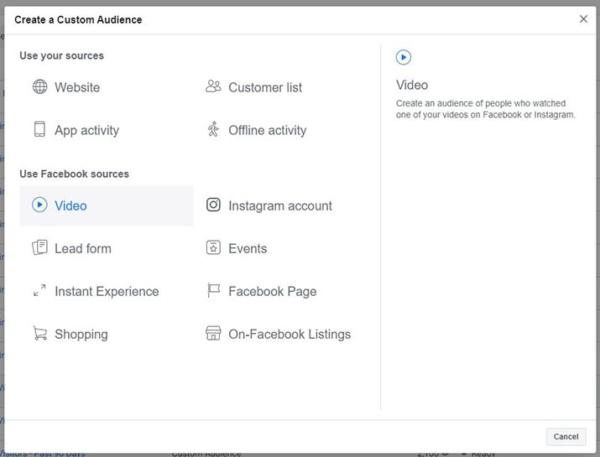
Creating a video engagement audience on Facebook Ads
When you create an audience, you’ll choose a video from your content library, set a date range to retarget, and choose between viewing percentage or viewing time. For example, you could retarget people who watched at least 25% of a video in the past 30 days.
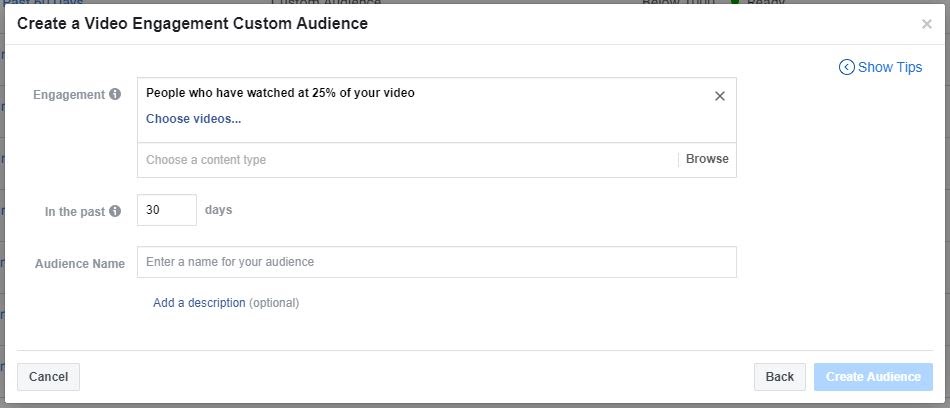
Engagement audience specifications
To show users a series of video ads, simply repeat this process, and create an audience for each video in the series.
17) Mobile App Engagement
If your business has a free mobile app, then odds are it’s pretty easy to get people to download it. According to Adroll, the average mobile user has over 100 apps on their phone.
The hard part is getting them to use it — not to mention pushing in-app purchases or upgrades to the paid version.
That’s where app engagement retargeting comes in handy. If someone has downloaded your app, you can set up retargeting ads to prompt users to take the next step.
Take this ad from UberEats, for example:
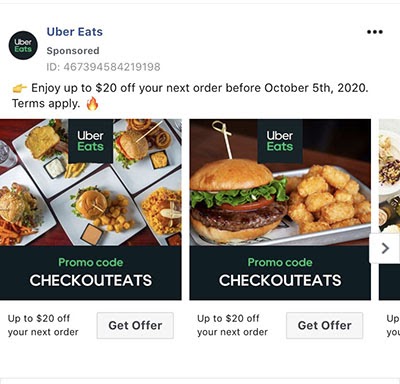
UberEats making sure you order again 🍔
Data from AppsFlyer indicates mobile app retargeting is the cheapest and most effective acquisition channel. In other words, using retargeting campaigns to keep app users engaged is crucial.
Optimizing Retargeting Ads
High performing retargeting campaigns can fade over time. To keep your campaigns in good shape, you have to optimize them regularly. This section will prioritize essential optimizations to maintain and improve ad performance.
Avoid ad fatigue
Ad fatigue happens when your audience gets bored of seeing your ads and stops paying attention to them.
Decreasing return on ad spend, lower click-through rates, and higher costs-per-result could all be symptoms of ad fatigue.
Don’t worry, ad fatigue is normal and easily cured. Here are a few quick fixes:
- Change out your images
- Reword your ad copy
- Try a different call to action
- Use a different ad format
Use all ad sizes
Not having the right ad size could cost you a placement and maybe even a customer. Make sure you research each platform and design ads in every recommended size.
You can reference our post for a complete list of Google Ads display ad sizes.
Adjust frequency caps
High frequency could be killing your performance, and setting a lower cap could fix your problems. This rule applies to frequency caps for Google and Facebook ads. At the same time, a few more impressions might be all it takes to earn a conversion.
For this reason, I recommend testing both higher and lower frequencies.
Design specific landing pages for retargeting campaigns
Implementing a post-click landing page for your retargeting campaigns can drastically improve performance.
Rather than sending visitors to your homepage, you can customize a page to match your offer.
Always be testing
Running the same ads with the same offer to the same audience is a recipe for failure. If you want your retargeting campaigns to succeed, you have to test new strategies. Testing includes A/B testing your ads and landing pages.
Conclusion
Retargeting is an essential component of your online marketing strategy. Without it, you’re leaving money on the table.
Of course, this doesn’t mean every retargeting campaign you create will be a success. Learning what works through trial and error is the only way to improve results. So keep testing new strategies. After all, persistence is ultimately the key to success.
Out of all the strategies we’ve covered, which one are you most excited about? Did I leave any strategy out? Let me know in the comments!
Luke Heinecke
Founder/CEO
Luke is in love with all things digital marketing. He’s obsessed with PPC, landing page design, and conversion rate optimization. Luke claims he “doesn’t even lift,” but he looks more like a professional bodybuilder than a PPC nerd. He says all he needs is a pair of glasses to fix that. We’ll let you be the judge.
Leave us a comment.
Subscribe to our blog
Subscribe to our blog
Get weekly PPC & CRO advice sent straight to your inbox.